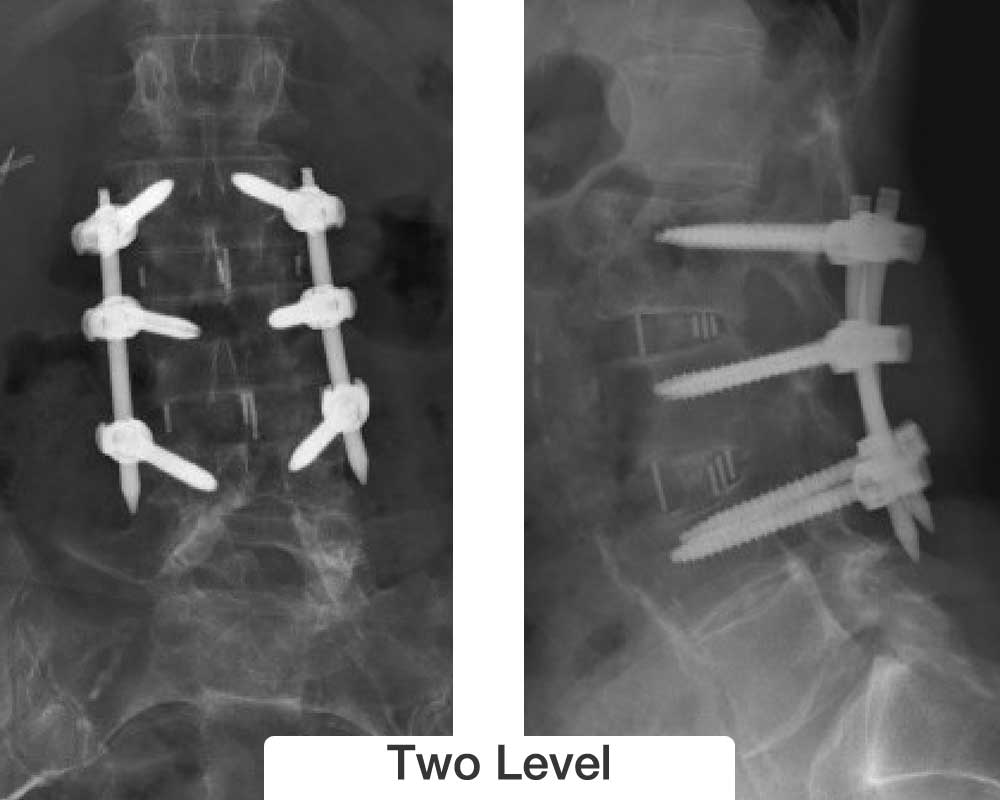LLIF Lateral Lumbar Interbody Fusion
Lateral Lumbar Interbody Fusion (LLIF) is a widely used surgical solution that has been rapidly adopted for treating conditions such as degenerative disc disease and other ailments affecting the discs in your lower back. LLIF is a spinal fusion procedure where surgeons access the side of the spine to fuse two or more vertebrae in the lower back together. The procedure involves collaboration between two surgeons; an “approach” surgeon, who provides access to the spine, and a spine surgeon who conducts the actual fusion procedure.
This surgical technique is sometimes referred to as DLIF (Direct Lateral Interbody Fusion, or XLIF (eXtreme Lateral Interbody Fusion). Both these names refer to the same technique. LLIF is more descriptive of the actual method employed.
LLIF treats conditions that occur when damaged or worn-out intervertebral discs put pressure on your spinal nerves . The procedure is performed from the lateral (side) side of the patient .
The Lateral Approach
The lateral approach requires that an incision to be made at waist level on the patient's side. A dilation tube is then used to provide access to the spine by passing between the abdominal organs in front (anterior) and the muscles of the back (posterior). The primary benefit of this direct access to the side of the spinal column. This approach allows for a more direct and thorough access to the damaged disc, while minimizing disruption to significant muscles, nerves, and vascular structure.

Benefits of the Lateral Approach
Undisturbed Back and Abdominal Muscles and Nerves: preservation of the anterior and posterior annular/ligamentous structures.
Enhanced Stability: A large spacer (spinal implant) may be used for enhanced stability of the fusion construct . This provides additional support and stability to the spine, promoting better healing and recovery .
Minimally Invasive: LLIF is considered a minimally invasive spine surgery. It preserves the abdominal muscles by separating muscle fibers instead of cutting them, and .
No Removal of Spinal Bone: LLIF does not require removing spinal bone to access the disc or vertebra . This reduces the risk of complications and promotes faster recovery .
Indications for LLIF
LLIF is indicated for various degenerative spinal conditions such as degenerative disc disease, mild to moderate degenerative scoliosis, low-grade spondylolisthesis, spinal stenosis, and disc herniations. It is also used in cases of mechanical back pain, spinal stenosis, recurrent disc herniation, fractures, tumors, degenerative scoliosis, spinal instability (spondylolisthesis), and revision of total disc replacement.
More About Fusion
Fusion is only performed after other treatments have proven to be ineffective. A LLIF procedure typically utilizes bone grafting of some type. Examples of bone graft methods include;
- Autograft is your living bone. The marrow contains bone-growing proteins. An autograft is collected from drillings during your surgery or is sometimes obtained from the hip as an iliac crest bone graft.
- BMA (bone marrow aspirate) is your own living bone marrow, collected with a syringe from the hip (iliac bone) or vertebra. This method is often less painless than iliac crest graft.
- Allograft is bone sourced from an organ donor, collected and stored by a bone bank. The type of graft has no bone-growing cells.
- Cellular bone matrix is allograft from an organ donor that contains bone-growing stem cells.
- BMP (bone morphogenetic protein) is sometimes added to bone-graft material to stimulate bone growth naturally in the body.

Dr. Goldstein is a leading expert in the use of the LLIF spinal procedure and possesses extensive experience in treating lumbar disorders using LLIF and other state-of-art surgical techniques. His expertise in minimally invasive spine surgery has been a key factor in his repeated recognition as one of New York’s “Best Doctors” by Castle-Connolly and New York Magazine for 10+ years."
